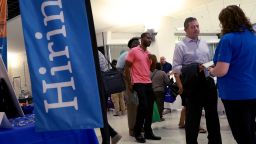With nearly two job openings available for every job seeker, the shortage of workers in the United States has many employers over a barrel in the fight to acquire and retain talent. But for candidates who are typically overlooked by hiring managers, the labor shortage offers an opportunity.
Advocates for marginalized populations such as people with disabilities, the formerly incarcerated and those who are housing-insecure, say today’s labor market is enabling the people they work with to demonstrate to employers — and themselves — that they can be valuable contributors to a thriving economy.
Employers today “are more willing to give an opportunity for someone… to demonstrate that they’re qualified for the job,” said Doug Smith, director of employment services at Chimes, a nonprofit organization that helps employ people with disabilities.
“We have, at least over the past year, seen a significant increase in the number of individuals being hired,” he said. While the percentage of people with a disability who work is still very low, at 22.5%, this does represent an increase from 21.6% a year ago, according to data from the Bureau of Labor Statistics.
Untapped labor pools
“I don’t think employers can be quite as picky as they were being before,” said Carley Kammerer, executive director of Wildflyer Coffee, a Minneapolis-based nonprofit organization that helps unhoused youth establish a stable living situation and acquire job skills. “There is a sense of dignity and worth that comes from employment… Sometimes, just that confidence of making your own way and making a paycheck can go a long way.”
Kammerer said small-business owners are tapping her for insight — and sometimes for workers. “People are almost seeing us as a staffing agency, so we’ve been able to increase opportunity and be almost like a pipeline or a referral source for our youth,” she said.

Brett Struwe, CEO of Sustenance Coffee in Minneapolis, said he had already raised pay by 15% to 20% when the labor market started to heat up last fall, but over the past six months he has found it harder to add the workers he needs to keep up with the growth of his business.
“You have to do a lot of active recruitment to get the amount of labor you need in order to grow the business,” Struwe said, adding that he has expanded his search and hired one of the young adults participating in the Wildflyer program to package coffee in his warehouse.
The worker has been such a good fit that Struwe said he is preparing to hire a second worker from the program this fall. “This is someone I want to be able to retain,” he said.
Fair-chance hiring gains momentum
People with a prior felony conviction face a different — and in many ways, greater — challenge, said Aaron Sojourner, a labor economist and senior researcher at the W. E. Upjohn Institute for Employment Research.
“Between 1980 and 2010, the share of Americans with a felony record tripled… the product of the rise in war on drugs and mass incarceration,” he said. “There’s just a lot more people in our communities now who have that experience and have that barrier than there used to be.”
But as employers scramble to fill open positions, fair-chance hiring, which refers to employment practices that don’t exclude or discriminate against candidates with criminal histories, is getting a closer look.
“We often don’t need to post for jobs… When word gets out that you’re in fair-chance hiring, you have people come to you,” said Amanda LaGrange, CEO of RePowered, a St. Paul, Minnesota-based company that recycles electronic waste and that runs an on-the-job training program for the formerly incarcerated.
“There’s a huge amount of talent, they’re just disconnected,” LaGrange said. “So much of our work is around stigma reduction.”
Employers today seem to be more receptive to those messages. “Employers are warming up to the idea of considering applicants they may not have previously, including those with a criminal record,” said AnnElizabeth Konkel, senior economist at Indeed.
Konkel said the number of job postings explicitly referencing these kinds of policies climbed by around 10% over the past three years, and the share of searches by job seekers using phrases like “no background check” has shot up by 75%. “This data tells us that employers are broadening the pool of employees that they will consider hiring, and job seekers are aware of this,” she said.

Gabriel Mandujano, founder and CEO of Wash Cycle Laundry, operates a commercial laundry service in the Philadelphia, Boston and Washington, D.C., metro areas.
“In most of our facilities, we have to operate seven days a week,” he said. “One of the more frequent things we see is people might leave for a Monday-to-Friday schedule, and that’s definitely something that didn’t happen as frequently before the pandemic.”
Mandujano said Wash Cycle has had a longstanding commitment to employing people who are often overlooked by hiring managers, including people with criminal records and people with disabilities, a value he said has helped him add workers even during a labor shortage.
Philadelphia resident Steve Stansbury had struggled to land stable employment since returning home in March 2021. “I know it’s because I have a record,” he said.
Stansbury, 34, was hired by Wash Cycle in November and promoted less than six months later. “I actually had a conversation with my boss asking me what I wanted to do. It’s what makes the job easier, because I’m doing something I like,” he said.
Stansbury said the job has given him a foundation to build a career and, he hopes, even start his own business one day. “I haven’t missed a day of work yet. I take it seriously… I don’t want to go back to jail. I’m really applying myself,” he said. “If I didn’t have this job, I don’t know what I’d be doing.”
Students are getting on-the-job experience
A lack of educational credentials or experience can also be a hurdle that keeps people from career-track work.
“We’re seeing [fewer] people that are experienced in retail or have longevity with jobs. That’s the wall we’ve been bumping up against,” said Elise Lark, stores and operations manager at Paxton Gate, a natural science-themed retailer in Portland, Oregon.
“Our payroll has increased at least 30% or more, and that’s just in the last year,” Lark said, and the store recently expanded its health coverage. But even with these efforts, their attempts at hiring fell short. “We’re basically like a natural history museum, so it’s very specialized retail… You need somebody who’s enthusiastic about natural sciences,” she said.
Through a program that pairs local college students with mom-and-pop businesses, Lark said her store was able to hire a biology major on a part-time basis during the busy holiday season. “This was a perfect opportunity for a student to learn real-world work experience,” she said.
Macy Buhler, owner of Yahara River Learning Center in DeForest, Wisconsin, said adding badly needed staff is a huge challenge. “Even some Targets are paying $19 an hour. I can’t compete with big companies right now, and that’s a struggle,” she said.
Her preschool educators should have credentials at roughly the level of an associate’s degree, but Buhler said the educational requirements can be a barrier for the young, working-class and often female child care labor pool. “They need to work full time. They don’t come from families where they can stop and go to school,” she said.
Buhler recently enrolled two new hires as part of a two-year pilot program run by the state that gives workers the opportunity to fulfill most of the requirements for their degree while being paid for on-the-job training.
“It’s a more supported way for them to go back to school. I have to support them by giving them time on the job to do schoolwork,” Buhler said, adding that one of her apprentices credited the program with making the attainment of a higher education feel accessible. “She doesn’t have people in her family who went to college [and] she told me she doesn’t have anybody to give her that example.”
The longer-term impact of worker shortages
The labor market was already tightening up before the pandemic. Waves of retiring baby boomers, falling birth rates, a shortage of child care and a slowdown in immigration all suggested a longer-term challenge for hiring managers. And all of these issues were exacerbated by the pandemic.
“As early as 2018, when we saw unemployment rates continue to drop, [we realized] we no longer have the luxury of broadly not considering people,” said Johnny C. Taylor Jr., president and CEO of the Society for Human Resource Management.
“The problem is the stigma” these populations often face from human resources and hiring managers, Taylor said. “Every employer has to… give people permission to hire from untapped pools of talent. We have to drive that into our organization.”
Attaining and maintaining stable employment is a critical part of drawing these people not only into the labor force, but into their communities at large, Sojourner said. “When people are locked out of the labor force, they struggle to find ways to contribute to the community,” he said.
Once employed, they can support themselves and their families and contribute meaningfully to the local economy.
It’s better for the workers themselves, too. “Getting an employment history definitely helps you stay employed,” Sojourner said. It is easier for workers to have their choice of jobs if they have references and a track record to demonstrate their commitment to a job.
And in an economy where the biggest wage gains are realized when workers switch jobs, having mobility is key to unlocking their earnings potential.
Taylor is optimistic that today’s job market and the likelihood that worker shortages will remain a challenge for employers could ultimately lower barriers for people who seek to enter or reenter the workforce.
“We’ve had a low and increasingly low American birth rate over the years [that] is not going to resolve itself,” he said. “I think there has been a true philosophical paradigm reset.”











